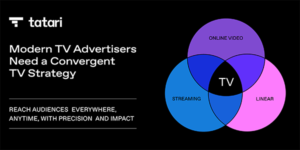This article is part of our September 2018 series about the state of advertising. Click here for more.
The back-to-school season this year was also the back-to-TV season for department stores. The top brands in the category spent $247.8 million from July 1 to Aug. 31, according to iSpot. That’s a 9.3% jump over the same period last year.
Indeed, a new study from Adobe, CMO.com’s parent company, which surveyed 1,000 U.S. TV buyers, found that marketers still rank TV higher than most digital formats—including audio, display, native, out-of-home, search, and social—in the “ability to build an emotional connection with a brand.”
However, less than a third (28%) of brands have integrated digital audience data into their TV ad buys, though 68% plan to do so in the next 12 months. Adobe’s survey results confirm what many in the industry already know: Despite recent progress in extending automation and data-driven buying to TV, most TV buys are still planned and executed manually with limited targeting and measurement.
Chris Geraci, chief investment officer at OMD, said he’s seeing a 5% jump in linear TV sales this year. “What you’ve got is a relatively strong economy, you’ve got good business results from consumer-facing companies, so you’ve got larger marketing budgets and you end up with more television spending,” he told CMO.com.
Ralph Heim, VP of media and sponsorships for Sonic Drive-in, concurred. “It still remains the biggest reach vehicle out there,” he told CMO.com.
That wasn’t the script analysts had in mind for 2018 after digital ad spending overtook TV ad spending for the first time the year before. Audiences for individual TV shows also continue to dwindle, with younger viewers cutting the cord in droves.
But as Walmart, Target, and the other top department store brands realize, people are still watching TV programming—whether it’s on a TV set or another device. The days when the whole family used to watch TV together may be rare, but marketers can be more sophisticated about their TV spending now. Addressability lets them target by personality and interest rather than demographics. New metrics connect ad exposure to results in real time and identify which ads are working best. Innovations are making TV advertising more compelling.
TV Is Still At The Center
One reason for TV advertising’s continued viability is, quite simply, it works. WARC, for instance, found that among the 100 global campaigns it has deemed most effective, a greater proportion were TV-led in the 2013 to 2016 timeframe than in the prior three years. After leading with social media, WARC saw more advertisers returning to TV to ensure maximum reach.
Research has shown that consumers pay more attention to TV advertising. A study by professor Karen Nelson-Field of the University of Adelaide, for instance, used to show that TV commanded twice the active viewing of YouTube. It also commanded 15 times the active viewing of Facebook.
“There is a reason most brand advertisers start their annual media planning around the TV upfronts. TV still commands a lion’s share of ad dollars and is unique in its ability to make an emotional connection with consumers,” said Keith Eadie, VP and GM of Adobe Advertising Cloud.
The challenge, Eadie said, is that TV viewing is now splintered across so many devices, apps, and networks. That makes reaching a critical mass of the target audience with the right creative at the right frequency hard. It can also “lead to issues like bombarding people with too many ads or not reaching a target audience in sufficient numbers for a campaign to work,” he told CMO.com.
Advertisers are navigating this environment by combining data about consumers with new delivery mechanisms for TV advertising, like addressable ads. Savvy advertisers are also putting TV at the center of omnichannel campaigns. If a consumer sees an ad on TV, they’ll then see an ad on their digital devices reinforcing that message.
New Ways To Target
Like outdoor or radio, television is a mass medium best-suited for reaching large, anonymous audiences. The prime metric for traditional TV, the Gross Ratings Point, is based on an estimation. Advertisers have no way of knowing whether the people who were theoretically exposed to an ad during such programming actually saw it, and they don’t know much about them except for their age and demographic.
But in the age of digital advertising, marketers can target on a more granular, addressable level. Behavioral targeting, which parses consumers’ online activities to gauge interest, has been around for more than 10 years. For instance, L’Oreal has used behavioral targeting to show TV ads to everyone who has bought lipstick in the past 30 days.
“It interests us to connect to see that a household is a QSR user and that household just went to [a competitor]. We know we share customers with [that company], and we’d like to get them back,” Heim said. “’Creative conquesting’ is the term that’s often thrown around for that type of targeting.”
The problem is, addressable TV represents just 3% of the overall market right now, according to eMarketer. Addressable TV is also expensive; marketers often find it’s cheaper to do a national buy than execute a targeted buy.
“Addressable appeals to certain advertisers at certain times when they’re trying to do certain things,” OMD’s Geraci said. “By and large, television is still a mass-reach platform.”
New Ways To Measure Results
It’s no secret that using sales as a proxy for TV advertising success just doesn’t work. Historically, the lag between exposure and sales results has been weeks, making it impossible to reshape a campaign if it’s not working. But nowadays marketers are more equipped to assess what’s working in real time.
According to Adobe’s Eadie, tools are available that measure television advertising by the brand recall, sales, store visits, and more. Additionally, advertisers can also solve common attribution problems, such as in-market bias—where a viewer who was already going to buy a given product sees an ad and the marketer incorrectly attributes the sale to the ad.
“Many attribution models are flawed today, and some platforms still grade their own homework, so we’re taking a statistical approach through experimental design for brands to independently measure results across media,” he said.
In addition to connecting exposure to results, marketers can also measure things like interruptibility—the frequency in which viewers tune out of an ad.
New Ways To Buy
The final way in which TV advertising is evolving is in how it’s bought and sold. While about 80% of display ads are bought and sold via programmatic, programmatic TV makes up just 2.8% of the overall TV spend, according to eMarketer.
Programmatic TV lets marketers execute TV buys on the same dashboard in which they execute their digital buys. It also lets marketers experiment with A/B testing and ad select, allowing viewers to pick the ads they want to see.
“When TubeMogul PTV—which subsequently became Adobe Advertising Cloud TV—first launched nearly four years ago, it was unthinkable that a major media company would open its entire portfolio of broadcast and cable television to automated, data-driven buying through private marketplaces,” Eadie said. But has since offered that level of inventory in partnership with Adobe Advertising Cloud.
The result of all these innovations is that while TV has become much more fragmented, there are new ways to make TV advertising more effective.
“If the world was passing TV by, if there was no way to optimize television, and you didn’t have this more sophisticated data, you wouldn’t be seeing the trends we’re currently seeing, which is a continued strong marketplace for ad-supported TV,” Geraci said.


